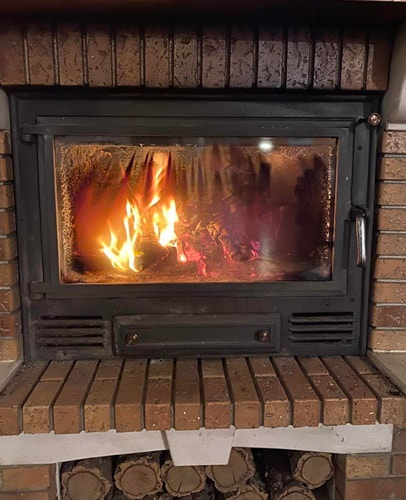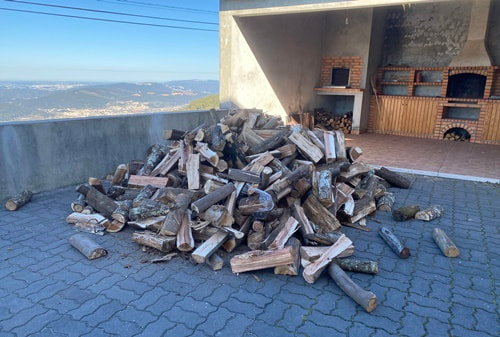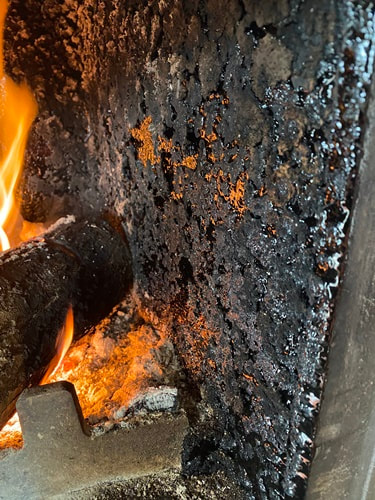|
When we moved into our new country home, we tackled a number of new experiences. One of which was the wood-fired whole house heating system. This post is how that system works and what difficulties you might encounter if you have one of these in your house. Both of our apartments in Porto had natural gas boilers with wall-mounted radiators. The house in the mountains has the same wall-mounted radiators, but the source of the hot water is our fireplace. This type of fireplace is called a back-boiler (recuperador in Portuguese) and it has a water reservoir that surrounds the firebox. Once the water reaches a certain temperature, a switch turns on and a pump circulates the hot water to all the registers. Ideally, that should warm the entire house. We are not amateurs when it comes to wood heating, however in the past it’s been wood stoves that only heated the air near that stove. We would turn on a fan beside the stove which would circulate the heat some, but it was usually limited to a single room. Using a wood fire to heat an entire house was a definitely something unexpected. Even this improved system has limitations and shares some of the same downsides of any other wood burning appliance— smoke, ash and sawdust. Whenever you open the door to add some wood, a puff of smoke comes out of the stove that will eventually coat everything in that room with a layer of dust and ash. This can be mitigated by letting the fire burn down, so it isn’t making much smoke, and by opening the damper and air intake and letting the fire burn hotter for a bit before opening the door. There is also some bark, sawdust and other litter that finds its way in front of the fireplace as a result of toting in the wood. And as Jana pointed out—buying black IKEA furniture (which instantly shows all this dust) wasn’t probably a great idea. Ha! The amount of smoke in the house is related to outside weather conditions such temperature, wind and barometric pressure. Rainy and overcast days have the tendency to reduce the draft, the amount of airflow you have going up the chimney. This will cause the unit to smoke more and the fire to burn more slowly since it is not getting as much air for combustion. Also, the wood you burn has a lot to do with the amount of heat the fire will produce. Well-seasoned wood will burn much cleaner and hotter with less smoke. This works great if you have the space to store a full year’s worth of firewood to allow it to season, but most of us aren’t that lucky. Seasoning firewood simply means to cut and split it and let it cure in an area out of the rain so the moisture in the wood can evaporate. This results in a fire that does not produce a lot of water vapor, along with the resulting steam and smoke that comes off the fire. If your wood is not well seasoned, you will hear it hiss and there will be a lot of popping while the fire burns. When we were on the farm in the United States, we had our own woodlot, and we were able to cut and stack the firewood ourselves. Now we are buying the wood and we pretty much take what is delivered, and usually it has not been well seasoned. We are now trying to buy what we need ahead of time, but just finding a dry area to store that much firewood is a challenge. An obvious location would be the carport, but the wood would be stored on top of the septic system and we’re thinking the extra weight might not be a good idea. Another reality of heating with wood is the threat of a chimney fire. This is the result of the buildup of creosote (see above) in the chimney damper and burning unseasoned firewood makes it worse. The creosote that forms is highly flammable. If it starts to burn, it grows extremely hot. This is a very dangerous situation. We once had a chimney fire in Iowa (the metal flu was vibrating, and we feared it would bust apart or the roar of flames would catch the roof on fire). It was absolutely frightening. When I start the fire in the morning, I will usually allow it to burn quite hot for several minutes to reduce the buildup of creosote. There are also some chemicals and special logs that are supposed to help reduce the buildup, but I have not been too impressed with some of the reviews I have seen. Occasionally building a very hot fire does the same thing as these other products. It is also vital that you have your chimney cleaned and inspected, preferably on an annual basis. Our friends, who bought a house in the area, had their fireplace inspected before they used it the first time. The interior of the flu was a disaster and needed extensive repair work. We cringe whenever we think of what might have happened if they’d just gone ahead and used the fireplace without that professional inspection. Also, be aware that not all fireplaces installed here have dampers, which was a surprise. As to types of firewood available, we can request two different grades: mixed and high density. Mixed is both hardwoods and softwoods. The benefit of softwoods like pine and eucalyptus is that they burn easier, however they do not generate a lot of heat. Hardwoods like oak and olive burn really hot, but it takes a very hot fire to get the fire started, and to keep it going. The mixture of hardwood and softwood allows for a fire that is easy to light and maintain, but generates an adequate amount of heat. So, how much heat are we talking about? Our fireplace is a Solzaima Zaima which is produced right here in Portugal and is considered to be a very good unit. The specifications say that it will burn 12 kg of wood per hour (about 25 pounds) and produce 20 kW of heat to the water, which would be approximately 70,000 btu. These are ‘ideal condition’ ratings and you are not likely to get quite that level of performance all the time. The specifications also state that it can heat an area a little over 800m3. This would be roughly equivalent to a 3500 sq foot house with 8-foot ceilings. For comparison, we had two furnaces (approximately 140K btu) in our brick house in Georgia. Sometimes when the weather was cold and windy it was difficult to get that house warm, and the furnaces would run almost continuously. In our new home we can get our downstairs living room up to 70 degrees F (21C) using the wood fire, but some of the upstairs rooms don’t get quite as warm. The bedrooms are upstairs and we usually like to have it a bit cooler when we are sleeping so that works out okay. We also don’t run the fire 24 hours a day, but let it go out to save middle of the night stoking runs. We did the same thing in Porto where we would turn the gas heat off at night while we slept. Portuguese houses are all tile and concrete and tend to hold the heat quite well once they get warm. Turning off the heat, or letting the fire go out, will normally only cause a small loss of temperature overnight. We sleep with heavy comforters and each have an electric mattress pad, so we are usually quite toasty. It was all going well until the fireplace didn’t work right. A few weeks after we moved in the bomba (pump) that moves the water around the house just died. Our first clue something was wrong was the cascade of hot water pouring out of the tank outside (up on the fireplace chimney). It arced out like crazy as it had nowhere to go. So water and steam into the air and no heat. Not good. We called the gentleman who had previously serviced the fireplace unit and he was booked until . . . February. (This was early December.) Okay, not an option since this our primary source of heat. We then contacted AllClima in Lousã (www.allclima.pt/) and within a day they had two servicemen at our house and a new pump was installed. We were thrilled because the new one is way more efficient than the old one. We have become quite accustomed to the wood heating system once we have learned some of the gotcha’s of starting and dealing with a wood fire. In combination with the electric mini-spilt units in the upstairs rooms (we don't use that often), we have been comfortable during our first winter in the Portuguese countryside. A winter that that our neighbors are saying is colder than normal. Now if we'd only get some rain! PRO TIP: Our fireplace is deep, deeper than you usually see in the States. Eventually it dawned on us that stacking the wood vertically rather than horizontally allowed us to pack the firebox and increase the amount of heat output. And it worked!
1 Comment
8/7/2023 07:47:41 am
Hey, thanks for sharing your knowledge about wood house and wood heating. I'm hooked on your blogs and can't wait to explore more on your website.
Reply
Your comment will be posted after it is approved.
Leave a Reply. |
Your HostsHarold is a former software engineer. Jana is an author. Together they're exploring their new life in Portugal. Archives
December 2022
Categories
All
|



 RSS Feed
RSS Feed